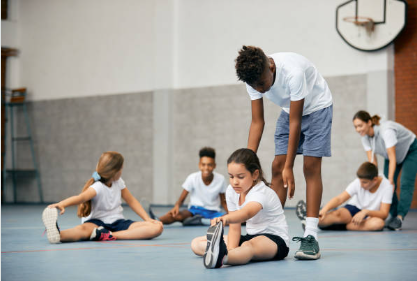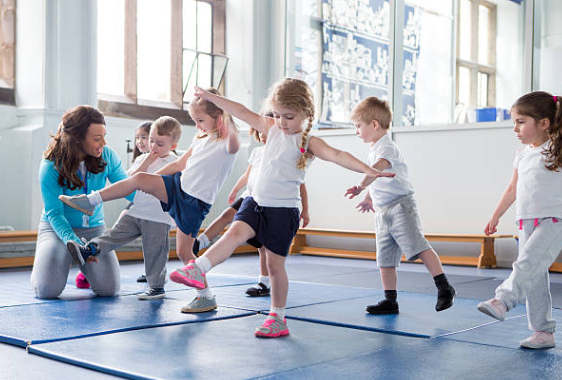Peer Review: An Evaluation of Moderate to Vigorous Physical Activity in an Elementary School QDPE Program

Previously published in Volume 83, Issue 2
Abstract
Although PE is mandatory from grade 1 through grade 10 in many provinces and territories in Canada (i.e., Alberta Education, n.d.; Province of British Columbia Ministry of Education, 2008), there are no guarantees that the time spent in PE class is quality time. Sixty-nine percent of Canadian schools report evaluating their PE program outcomes (such as increased skill and knowledge) at least once per year (Canadian Fitness & Lifestyle Research Institute, 2012); however, time spent being physically active is not captured (or assessed) by the school. Teachers, whether specialist or not, are not required to measure how active children are during PE. Evidence states that children are not meeting the recommended standards of 60 minutes of daily MVPA (Statistics Canada, 2015) or at least 50% (US Department of Health and Human Services, 2000) of PE class time being spent in MVPA (Fairclough & Stratton, 2006). The aim of this study was to determine if Canadian children could attain 50% MVPA during PE class time as determined by the System for Observing Fitness Instruction Time (SOFIT; McKenzie, Sallis, & Nader, 1991) when led by a kinesiology trained PE specialist.
Schools are a key environment in which children can be physically active and healthy (Gray, Young, & Barnekow, 2007). Most Canadian children spend approximately half of their waking weekday hours in school, making it an exceptionally important venue for health promotion and intervention (Public Health Agency of Canada, 2010). Physical education (PE) is one subject that can directly impact health outcomes by reducing sedentary time, a known health risk. Physical activity (PA) can also lead to improved academic outcomes including GPA and classroom behaviour (Carlson et al., 2008; Coe, Pivarnik, Womack, Reeves, & Malina, 2006; Rasberry et al., 2011; Trudeau & Shephard, 2008).
PE is a specialty school subject that often suffers from a lack of specialist teacher delivery. By using classroom generalists to teach specialties, the role that these courses play in cognitive, social and affective development is marginalized (Bresler, 1994). Research demonstrates that children in PE classes taught by specialists spend more time in moderate to vigorous PA (MVPA) than those in PE classes taught by general classroom teachers (McKenzie et al., 1995; McKenzie et al., 2001; Sallis et al., 1997). This is due, in part, to the inadequate implementation of PE curricula taught by non-specialists where programming, planning, assessing, evaluating and reporting are subpar (Morgan & Hansen, 2007). Non-specialist preservice and in-service teachers have expressed that they possess only moderate levels of confidence in teaching PE, and that low confidence stems from poor experiences of their own childhood PE classes and a lack of training and support to teach meaningful classes (Morgan & Bourke, 2008). These teachers reported that they primarily use PE time to supervise games, while providing little teaching and learning (Morgan & Bourke, 2008).
Although PE is mandatory from Grade 1 through Grade 10 in many provinces and territories in Canada (i.e., Alberta Education, n.d.; Province of British Columbia Ministry of Education, 2008), there are no guarantees that the time spent in PE class is quality time. Sixty-nine percent of Canadian schools report evaluating their PE program outcomes (such as increased skill and knowledge) at least once per year (Canadian Fitness & Lifestyle Research Institute, 2012); however, time spent being physically active is not captured (or assessed) by the school. Teachers, whether specialist or not, are not required to measure how active children are during PE. Evidence states that children are not meeting the recommended standards of 60 minutes of daily MVPA (Statistics Canada, 2015) or at least 50% (US Department of Health and Human Services, 2000) of PE class time being spent in MVPA (Fairclough & Stratton, 2006).
The aim of this study was to determine if Canadian children could attain 50% MVPA during PE class time as determined by the System for Observing Fitness Instruction Time (SOFIT; McKenzie, Sallis, & Nader, 1991) when led by a kinesiology trained PE specialist.

Methods
We collected data throughout the 2015/16 school year. The school selected for this study has received awards from Physical and Health Education Canada for its quality daily PE (QDPE) program taught exclusively by PE specialists. The charter school (Foundations for the Future Charter Academy - Southwest Elementary campus) is based in the southwest quadrant of Calgary. The school has students in Kindergarten through Grade 4 and boasts a substantial waitlist, indicating the quality of education that the school provides.
Participants
Participants were boys and girls in Grades 1 through 4, as well as their PE teachers. PE teachers were trained specialists with Canadian undergraduate degrees in kinesiology/physical education, and Bachelor of Education after-degrees. Delivery of the Alberta PE curriculum was based on the Sports, Play and Active Recreation for Kids (SPARK) program, which outlines the structure of the PE class, class plans, and supports for teachers. Fourteen (four Grade 1, four Grade 2, three Grade 3, and three Grade 4) classes were enrolled in this study, taught by two female PE teachers, one full time and one part-time.
Procedures
Measurement followed the SOFIT protocol (McKenzie et al., 1991); a brief description follows. One trained observer brought with him to each class a pen, a clipboard, SOFIT observation sheets, and a portable audio (iPod) player with the pre-recorded prompts. He randomly selected four participants (two boys and two girls) to observe throughout the 34-minute class. In addition, a fifth participant was chosen in case one of the original four left or could not be located during an observation period. Each participant was observed for a total of four minutes in 20-second intervals (10 seconds to observe, 10 seconds to record). Upon completion of this observation, the focus shifted to another of the selected participants, eventually returning to the first participant to repeat the pattern. During the direct observation period, the observer watched and recorded PA while simultaneously observing and recording class context and instructor interaction. This procedure was used to observe 54 classes, of varying grade levels, distributed throughout the school year.
We measured PA on a five-point hierarchical scale: 1) lying down, 2) sitting, 3) standing, 4) walking, and 5) vigorous (defined as more energy expenditure than an ordinary walk). MVPA is the combination of categories 4 and 5 according to the SOFIT protocol. The activity that took place within the observation period with the highest number was recorded (for example, if standing and running were both observed during the 10s interval, it would be coded as vigorous).
Lesson context (LC) consisted of three non-hierarchical categories: general content (transition, management and break); knowledge content (primary focus is on the acquisition of knowledge related to PA, rules, strategy and social behavior); and PA motor content which is itself divided into fitness (such as endurance, strength or flexibility); skill practice (primary goal is skill development, such as drills); game play (application of skills with little instructor involvement); and free play (instruction is not intended and children may choose to participate or not).
We coded Teacher interactions (TI) with one of six hierarchical codes: 1) promotes fitness (prompting or encouraging PA participation); 2) demonstrates fitness (models fitness engagement); 3) instructs generally (lectures, describes, prompts or provides feedback); 4) manages (participants or the environment in non-subject matter tasks, such as set-up); 5) observes (monitors the group or an individual); and 6) other task (attends to events not related to the responsibilities of the class). The activity that took place within the observation period with the lowest number was recorded (for example, if promotes fitness and manages were both observed, then promotes fitness was recorded).
Statistical methods
Descriptive statistics for categories of PA, LC, and TI were reported as median and interquartile range. The Wilcoxon Sign Rank test was used to assess any gender differences in PA levels. To look at the relationship between category of LC/TI and MVPA, regression analysis was considered. Since the plots did not show a linear pattern, linear regression with continuous predictor variables could not be used. Instead, each component of LC and TI was divided up into quartiles (four categories with 25% of the observations in each category) and box plots were created to show the distribution of MVPA across the new categorical variables. Linear regression was then used with categorical predictor variables and one model was generated for each predictor variable to show the estimated proportion of time spent in MVPA. P-values were reported from the regression results for significant findings (p<0.05) where the reference group was the lowest quartile of LC or TI component compared to each quartile higher within the same component. To assist with interpretation of the models, a bar graph was also created for each component of LC and TI where the height represents the estimated proportion of time spent in MVPA across each quartile of the predictor variable. All analyses were conducted in Stata S/E Version 13 (StataCorp, 2013).
Results
We recorded SOFIT results during 54 observation days of 11 activities from the Alberta PE curriculum. Activities included combatives (introductory wrestling activities and games), cup stacking, dance, DrumFIT®, fitness circuit, football, gymnastics (body mastery and movement education approach), jumping rope (long and short rope), tag games, and object manipulation skills instruction (including striking, throwing and catching drills). Table 1 shows the amount of time spent in each of the five SOFIT activity categories, overall and by gender. There were no gender differences in activity levels (all p>0.05). Table 2 presents the lesson context and teacher interaction variables, and the percent of time spent in each category.
Note: Sedentary = sum of lying, sitting, standing; MVPA = sum of moderate and vigorous. The median values for Sedentary and MVPA are not equal to the sum of their components, as the distributions are skewed. p = p-value from the Sign Rank test for paired data. IQR = Interquartile Range
Note: PA Content = sum of fitness, skills, game play, free play; Teaching = sum of demonstrates and instructs. The median values for PA Content and Teaching are not equal to the sum of their components, as the distributions are skewed. IQR = Interquartile Range
Figure 1 is a representation of the relationship between the components of Lesson Context and MVPA by quartile. Differences between Q1 and Q4 in General Content and Fitness show significant trends, further explored in Figures 2 and 3. Free play was excluded from analysis as 91% of the observations received a 0 value.
Figure 1. Boxplots (by quartile) demonstrating the relationships between MVPA and Lesson Context components.
Figure 2. Percent of time spent in MVPA by Lesson Context - General Content. The graph shows that students participated in significantly more MVPA when PE teachers focused on General Content for less than 15% of class time (58% vs. 47%; p=0.021).
Figure 3. Percent of time spent in MVPA by Lesson Context - Fitness. Students who spent more than 23% of PE time in Fitness spent, on average, 59% of time in MVPA; 13% more than those in the lowest quartile (p=0.006).
Boxplots were created for each component of TI (Figure 4). Here we can see the relationships between the components and MVPA, particularly in Praise (Q1 vs Q4), Demonstrates (Q1 vs Q4), and Manages (Q1 vs Q4), shown in Figures 5-7. Other tasks were excluded from analysis as 81% of observations received a 0 value.
Figure 4. Boxplots (by quartile) demonstrating the relationships between MVPA and Teacher Interaction components.
Figure 5. Percent of time spent in MVPA by Teacher Interaction - Praise. Teachers who spent more than 30% of class time praising students saw a significant increase in MVPA (18%) compared to teachers who spent less than 8% of class time praising students (63% vs. 45%; p < 0.001).
Figure 6. Percent of time spent in MVPA by Teacher Interaction - Demonstrates.
Figure 7. Percent of time spent in MVPA by Teacher Interaction - Observes.
Discussion
This study aimed to determine how much time children in a QDPE school program spent in MVPA. Using systematic observation, we captured the relationship between time spent being physically active, the PE lesson context and the teacher interactions with students. Results show that it is possible for children to achieve the 50% MVPA goal for PE class time as recommended by North American national health bodies (NASPE, 2004, US Department of Health and Human Services, 2000), and that this expectation is realistic. Results also show that certain lesson contexts and teacher interactions have a greater impact on MVPA than others.
When teachers spend less than 15% of class time managing students, the children are significantly more likely to be participating in MVPA (58% of class time). Several other studies demonstrate similar results, where higher management times produce less PA time (Bevans, Fitzpatrick, Sanchez, Riley, & Forrest, 2010; Dudley, Okely, Pearson, Cotton, & Caputi, 2012; McKenzie, Marshall, Sallis, & Conway, 2000; McKenzie, Sallis, et al., 2004). The present study, however, is novel in that cut points are provided to identify where drop-offs in student PA begin.

Several opportunities exist to reduce the amount of inactive management time while still maintaining the efficiency of the class. As Rink and colleagues say, “Waiting in line and sharing equipment in physical education are the equivalents of students sharing a pencil or book in the classroom” (2008, p. 212). Reducing the teacher-to-student ratio significantly increases student time spent in MVPA (Bevans et al., 2010). Having access to well-maintained equipment and facilities reduces management and transition time between groups and activities (Dwyer et al., 2003). Previous studies report that management time can be reduced by teaching single-gender classes (Dudley et al., 2012; Smith, Lounsbery, & McKenzie, 2014); however this result is not universal (McKenzie, Prochaska, Sallis, & Lamaster, 2004). Since it requires no further funding or resources, possibly the easiest solution to implement is to have students be active during management times, such as doing the warm up while taking attendance or while handing out equipment. Lastly, having a detailed lesson plan and establishing routines should help the PE teacher and students remain on task (Rink et al., 2008).
Another lesson context that significantly impacts MVPA is the fitness component. Classes that focus more on fitness (i.e., endurance, strength and flexibility) see children surpass the 50% of class time in MVPA threshold. In the present study, students who spend more than 15% of class time participating in fitness activities are able to achieve greater than 50% MVPA over the course of the class. Other studies have also found that more time spent in fitness increases PA levels (McKenzie et al., 2000; Skala, Springer, Sharma, Hoelscher, & Kelder, 2012). Taking this one step further, classes that are conducted outdoors tend to focus more on fitness than knowledge and, therefore, facilitate more active students (Skala et al., 2012).
Surprisingly, gender does not yield significant results in this study; however, gender should be taken into account when designing a PE curriculum. In general, boys are more active than girls (McKenzie et al., 2000; McKenzie, Prochaska, et al., 2004; Smith et al., 2014). A study from Mexico City found that an increased focus on fitness led to decreased MVPA in girls (Jennings-Aburto et al., 2009). Reasons for this gender difference may include that girls do not wish to get sweaty (Couturier, Chepko, & Coughlin, 2007; Oliver, Hamzeh, & McCaughtry, 2009) and that they tend to favour cooperative games rather than competitive sports (Azzarito, Solmon, & Harrison, 2006; Couturier et al., 2007). Effective PE planning should include non-traditional sport activities, such as yoga and other alternative games that are active and equally appealing to both genders.
Teacher interactions play an important role in student outcomes. This study highlights that when teachers spend more time praising students (30% and above), students are more likely to be active (63% of class time). One reason why praise may be so effective in increasing MVPA is because praise is an indication of observation and engagement on the part of the teacher. Immediate feedback on a skill offers the opportunity for the student to either modify or continue a behaviour, giving them the necessary control to boost intrinsic motivation (Rink et al., 2008; Xiang, McBride, & Solmon, 2003). The SPARK program used at the school in this study has a heavy emphasis on individualized praise and student directed positive feedback.
Figures 6 and 7 represent the value of teacher engagement during the lesson. The importance of demonstrations is often emphasised in pre-service PE curriculum and instruction courses. The demonstration of a new skill or activity (such as a drill or game) provides the opportunity for the student to visually understand what the teacher is trying to explain. The additional type of input results in a greater number of children transitioning more quickly from standing or sitting to resuming PA. Figure 6 may suggest that teachers who don't demonstrate or who use demonstrations sparingly have students taking longer to engage in PA. This may be a result of confusion or follow up questions that take time away from PA. Figure 7 reveals that the more a teacher simply stands around and watches, the less engaged the students are in MVPA. Teacher interactions such as providing praise to students, doing demonstrations or providing instruction are more desirable and lead to great levels of MVPA.
Objective measurement should be considered when evaluating PE programming. The National Association for Sport and Physical Education (NASPE) states that evaluation should not simply be used as means to evaluate performance, but to enhance learning (NASPE, 2004). The SOFIT protocol allows for this to take place by providing feedback on student PA time and quality feedback to teachers through the context and interaction pieces, thereby providing a more complete picture of what takes place in evaluated PE classes. Although systematic observation is time consuming and may be costly, alternatives do exist. Strategies that can be used in ongoing teacher training include video-taping to conduct peer or self-analysis, using colleagues to objectively observe the amount of PA time, or utilizing SOFIT protocols in partnership with volunteers (e.g., university practicum students).
Being mandatory and free, school PE is an equalizer for providing children with the opportunity to participate in a quality PE experience in order to build the appropriate foundational skills to be able to enjoy PA for life. Focussing on specific class elements such as management, fitness and praise helps to maximize benefits of PE, and is successful in increasing MVPA in elementary school-aged students.

Future research might wish to consider the ratio between moderate and vigorous PA towards meeting the North American objectives for MVPA. The 50% MVPA threshold can be met in various ways, with varying degrees of energy expenditure. For example, 40% moderate physical activity (MPA) and 10% vigorous physical activity (VPA) is a much lower level of exertion than 10% MPA and 40% VPA. Future research should consider the metabolic output of different PE situations with varying levels of VPA.
Conclusion
This research concludes that it is possible for a QDPE program, taught by a PE specialist, to achieve the minimum threshold of 50% MVPA over the course of a school year. Specific evidence-based recommendations are provided below that may help a teacher achieve this objective:
- Provide a generous amount of praise to students.
- Use demonstrations to help students understand instructions of new skills or activities.
- Be intentional about reducing the amount of time students are listening to instructions.
- Prepare ahead to reduce the time it takes for non-instructional tasks like setting up or completing transitions.
- Engage with students throughout the class and avoid simply being an observer.
- Regularly include an element of fitness in every class to maximize MVPA.
The author would like to thank the Superintendent of Foundations for the Future Charter Academy for granting access to its Southwest Elementary school campus. Thank you as well to the school Principal and Physical Education teachers for permitting the research assistants access to the PE classes. The author would also like to acknowledge the assistance of the research team throughout this project, including the research assistants that were led by Dr. Nadine Van Wyk (Research Coordinator), Kim Nagan (Editorial Advisor) and Jodi Siever (Bio-Statistician). Finally, the author wishes to acknowledge the ongoing research support related to systematic observation from Vivo for Healthier Generations. Vivo is a Calgary charity that is committed to working with partner organizations in the pursuit of innovative and evidence-based health solutions in schools and the community.
References
Alberta Education. (n.d.). Daily physical activity initiative. Retrieved from https://education.alberta.ca/teachers/resources/dpa/
Azzarito, L., Solmon, M. A., & Harrison, L. (2006). “...If I had a choice, I would....” a feminist poststructuralist perspective on girls in physical education. Research Quarterly for Exercise and Sport, 77(2), 222-239. doi:10.1080/02701367.2006.10599356
Bevans, K. B., Fitzpatrick, L. A., Sanchez, B. M., Riley, A. W., & Forrest, C. (2010). Physical education resources, class management, and student physical activity levels: A structure‐process outcome approach to evaluating physical education effectiveness. Journal of School Health, 80(12), 573-580.
Bresler, L. (1994). Music in a double bind: Instruction by non-specialists in elementary schools. Arts Education Policy Review, 95(3), 30-36.
Canadian Fitness & Lifestyle Research Institute. (2012). Encouraging active schools: 2011 opportunities for physical activity at school survey. Retrieved from Ottawa, ON:http://www.cflri.ca/sites/default/files/node/1054/files/Schools%202011%20Bulletin%2012%20%20Policy%20EN.pdf
Carlson, S. A., Fulton, J. E., Lee, S. M., Maynard, L. M., Brown, D. R., Kohl III, H. W., & Dietz, W. H. (2008). Physical education and academic achievement in elementary school: Data from the early childhood longitudinal study. American Journal of Public Health, 98(4), 721-727.
Coe, D. P., Pivarnik, J. M., Womack, C. J., Reeves, M. J., & Malina, R. M. (2006). Effect of physical education and activity levels on academic achievement in children. Medicine and Science in Sports and Exercise, 38(8), 1515.
Couturier, L. E., Chepko, S., & Coughlin, M. A. (2007). Whose gym is it? Gendered perspectives on middle and secondary school physical education. Physical Educator, 64(3), 152-158.
Dudley, D. A., Okely, A. D., Pearson, P., Cotton, W. G., & Caputi, P. (2012). Changes in physical activity levels, lesson context, and teacher interaction during physical education in culturally and linguistically diverse australian schools. International Journal of Behavioral Nutrition and Physical Activity, 9(1), 1.
Dwyer, J. J., Allison, K. R., Barrera, M., Hansen, B., Goldenberg, E., & Boutilier, M. A. (2003). Teachers' perspective on barriers to implementing physical activity curriculum guidelines for school children in toronto. Canadian Journal of Public Health/Revue Canadienne de Sante'e Publique, 448-452,
Fairclough, S. J., & Stratton, G. (2006). A review of physical activity levels during elementary school physical education. Journal of Teaching in Physical Education, 25(2), 239.
Gray, G., Young, I., & Barnekow, V. (2007). Developing a health-promoting school: A practical resource for developing effective partnerships in school health, based on the experience of the european network of health promoting schools: European Network of Health Promoting School
Jennings-Aburto, N., Nava, F., Bonvecchio, A., Safdie, M., González-Casanova, I., Gust, T., & Rivera, J. (2009). Physical activity during the school day in public primary schools in mexico city. Salud Publica de Mexico, 51(2), 141-147.
McKenzie, T. L., Feldman, H., Woods, S. E., Romero, K. A., Dahlstrom, V., Stone, E. J., . Harsha, D. W. (1995). Children's activity levels and lesson context during third-grade physical education. Research Quarterly for Exercise and Sport, 66(3), 184-193.
McKenzie, T. L., Marshall, S. J., Sallis, J. F., & Conway, T. L. (2000). Student activity levels, lesson context, and teacher behavior during middle school physical education. Research Quarterly for Exercise and Sport, 71(3), 249-259. doi:10.1080/02701367.2000.10608905
McKenzie, T. L., Prochaska, J. J., Sallis, J. F., & Lamaster, K. J. (2004). Coeducational and single-sex physical education in middle schools: Impact on physical activity. Research Quarterly for Exercise and Sport, 75(4), 446-449.
McKenzie, T. L., Sallis, J. F., & Nader, P. R. (1991). Sofit: System for observing fitness instruction time. Journal of Teaching in Physical Education, 11(2), 195-205.
McKenzie, T. L., Sallis, J. F., Prochaska, J. J., Conway, T. L., Marshall, S., & Rosengard, P. (2004). Evaluation of a two-year middle-school physical education intervention: M-span. Medicine & Science in Sports & Exercise, 36(8), 1382-1388.
McKenzie, T. L., Stone, E. J., Feldman, H. A., Epping, J. N., Yang, M., Strikmiller, P. K., . . .Parcel, G. S. (2001). Effects of the catch physical education intervention: Teacher type and lesson location. American Journal of Preventive Medicine, 21(2), 101-109. doi:http://dx.doi.org/10.1016/S0749-3797(01)00335-X
Morgan, P., & Bourke, S. (2008). Non-specialist teachers' confidence to teach pe: The nature and influence of personal school experiences in pe. Physical Education and Sport Pedagogy, 13(1), 1-29. doi:10.1080/17408980701345550
Morgan, P., & Hansen, V. (2007). Recommendations to improve primary school physical education: Classroom teachers' perspective. The Journal of Educational Research, 101(2), 99 108. doi:10.3200/JOER.101.2.99-112
NASPE. (2004). Moving into the future: National standards for physical education (2nd ed.). Boston: McGraw Hill Higher Education.
Oliver, K. L., Hamzeh, M., & McCaughtry, N. (2009). Girly girls can play games: Co-creating a curriculum of possibilities with fifth-grade girls. Journal of Teaching in Physical Education, 28(1), 90-110.
Province of British Columbia Ministry of Education. (2008). Physical education 8 to 10: Integrated resource package 2008. Retrieved from http://www.bced.gov.bc.ca/irp/course.php?lang=en subject=Physical_Education&course=Physcal_Education_8_to_10&year=2008
Public Health Agency of Canada. (2010, May 23, 2012). Curbing childhood obesity: A federal, provincial and territorial framework for action to promote healthy weights Retrieved from http://www.phac-aspc.gc.ca/hp-ps/hl-mvs/framework-cadre/index-eng.php
Rasberry, C. N., Lee, S. M., Robin, L., Laris, B., Russell, L. A., Coyle, K. K., & Nihiser, A. J. (2011). The association between school-based physical activity, including physical education, and academic performance: A systematic review of the literature. Preventive Medicine, 52, S10 S20.
Rink, J., xa, E, Hall, T., xa, & J. (2008). Research on effective teaching in elementary school physical education. The Elementary School Journal, 108(3), 207-218. doi:10.1086/529103
Sallis, J. F., McKenzie, T. L., Alcaraz, J. E., Kolody, B., Faucette, N., & Hovell, M. F. (1997). The effects of a 2-year physical education program (spark) on physical activity and fitness in elementary school students. American Journal of Public Health, 87(8), 1328-1334. doi: http://doi.org/10.2105/AJPH.87.8.1328
Skala, K. A., Springer, A. E., Sharma, S. V., Hoelscher, D. M., & Kelder, S. H. (2012). Environmental characteristics and student physical activity in pe class: Findings from two large urban areas of texas. Journal of Physical Activity & Health, 9(4), 481.
Smith, N. J., Lounsbery, M. A. F., & McKenzie, T. L. (2014). Physical activity in high school physical education: Impact of lesson context and class gender composition. Journal of Physical Activity & Health, 11(1), 127-135.
StataCorp. (2013). Stata statistical software: Release 13. College Station, TX: StataCorp LP. Statistics Canada. (2015). Directly measured physical activity of children and youth, 2012 and 2013. (82-625-X2015001). Ottawa, ON Retrieved from http://www.statcan.gc.ca/pub/82-625x/2015001/article/14136-eng.htm.
Trudeau, F., & Shephard, R. (2008). Physical education, school physical activity, school sports and academic performance. International Journal of Behavioral Nutrition and Physical Activity, 5(1), 10.
US Department of Health and Human Services. (2000). Healthy people 2010 (1883205751). Retrieved from Washington, DC:
Xiang, P., McBride, R. E., & Solmon, M. A. (2003). Motivational climates in ten teachers' elementary physical education classes: An achievement goal theory approach. The Elementary School Journal, 104(1), 71-91.








